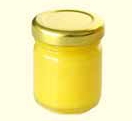The Dandelion has traditionally been a nutritious source of food and a natural remedy for a wide variety of ills. Ironically it has been relegated to the status of a weed and is the focus of thousands of home owners’ annual lawn care struggle. Fortunately, while we may have forgotten how to use them, bees have not, and dandelion honey is the delicious consequence. However as a single flower (monofloral) honey, dandelion is rare, as it competes with other nectar producing plants growing at the height of the flowering season from April to May and beekeepers often leave this honey produced early in the season as food for the bees themselves to strengthen their hive in preparation for subsequent types of blossoms. On the other hand, because of the strength of its flavor, a pollen count as low as 5% is sufficient to be considered monofloral and can range from 5% to 65%. Its high glucose content causes it to crystallizes quickly and for this reason it can also be difficult to harvest.
Dandelion honey color ranges from an intense golden yellow to a darker hue as it crystallizes. A vivid yellow color is indicative of greater purity. It has a pungent, sharp taste and an aroma reminiscent of the flower itself but stronger like an essential oil of dandelion. The aroma is described as ammonia, chamomile, vinegar, animal glue and apparently can be initially repellent for those unfamiliar with this honey (not my experience).
The taste is strong with medium sweetness and a slightly astringent lingering aftertaste that has been described as refreshing. A creamy, buttery texture suits an application on toast and this combination makes a fine morning treat. I preferred it slightly liquefied with gentle heating and ended up eating it straight out of the jar.
Young dandelion leaves make an excellent salad often enjoyed in Europe and are rich in Vitamin A, K and calcium. From a therapeutic point of view, dandelions and dandelion honey help the liver and kidneys to do their work and keep the bowels in a healthy condition, particularly important to dyspeptics as it does not cause wakefulness.
Latin Name: Taraxacum officinale (Weber), Family: Asteraceae
Other important nectar producing members of the Asteraceae family are, Centaurea (Knapweed), Helianthus annuus (Domestic Sunflower), and some species of Solidago (Goldenrod)
Honey Origin: Europe
Translations: French: Miel de Pissenlit; Italian: Miele di Tarassaco; Spanish: Diente de León Miel; German: Löwenzahnhonig
Recognition: Listed in the International Ark of Taste – Dandelion Honey, Piedmont, Italy. Foods included in the list are intended to be “culturally or historically linked to a specific region, locality, ethnicity or traditional production practice”, in addition to being rare.





Wher can you buy Dandelion honey the UK?
This year we were able to get this amazing and fairly rare honey from Sweet Nechako Honey in Vanderhoof, BC, Canada.
Thanks Carol! I also was able to order some online last week from Ames honey in Minnesota that I am waiting for now. Also I picked up a mild version from Saugeen Country Honey Inc. in Ontario, Canada.
…Scott
Hi Scott
Your website has cropped up a lot in my research and a quick search did not find any of our honeys. We import and distribute many world honeys and they are all raw. Please check out our website. If you’re interested, we would be glad to send you samples.
Thanks
Susan Worrall
Sales Manager
18882566603 x 223